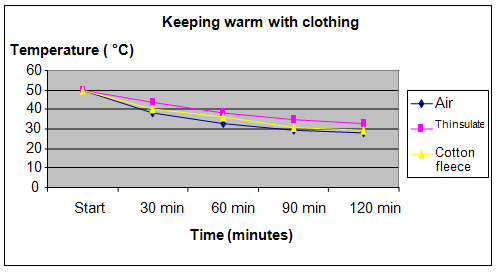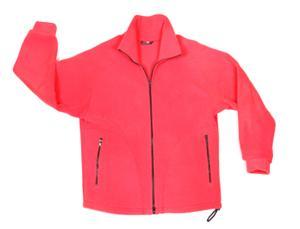| Complexity level: | 6 |
| Project cost ($): | 30 |
| Time required: | 1 hour to prepare, 2 hours for the science project experiment |
| Material availability: | Easily found. You can try borrowing some old clothing for the experiment |
| Safety concerns: | Handle hot water carefully. Adult assistance is required. |
Hypothesis
Thinsulate fabric retains heat and keeps water in a flask warm for the longest period of time,
Overview
Clothes to keep warm
Clothing protects us from the sun on hot days and helps to keep us warm on cold nights. It also protects us from injuries, insect bites and extreme weather conditions like strong winds, rain or snow.
The type of clothing used will vary between different countries and cultures. Human beings have survived by adapting and modifying the clothes we wear to suit our environment. Some cultures living in warm regions like the African deserts , require little clothing. Others living in colder climates wear thicker and denser clothing.
Choosing the correct type of clothing to wear is especially important in countries with 4 seasons. Materials used in clothing like cotton or wool are normally poor conductors of heat. There is air, which itself is a thermal insulator, trapped in between the gaps in the fiber to help keep us warm. Both natural fibers and synthetic fibers are used in making clothing for different climates.
Scientific Terms
Materials
The materials required for this science project::
- 3 conical flasks
- 3 corks
- 1 electric drill with the bits
- 3 thermometers
- 1 scarf made from Thinsulate fabric
- 1 scarf made from cotton fleece
- 2 strings
- Tap water
- 1 hot plate
- 1 clock
Procedure
1. For this science project, the independent variable is the type of fabric used to insulate the flask – air, Thinsulate scarf or cotton fleece scarf. The dependent variable is the temperature of the water in the conical flask. This is determined by using the thermometer to measure the temperature. The constants (control variables) are the size of the conical flask, the amount of water in the flask and the room temperature.
2. A hole is made in the middle of the 3 corks using the electric drill. The diameter of the hole should be almost the same as the diameter of the thermometer. The thermometers are then inserted into the corks.
3. Three conical flasks are filled with tap water. The cork with the thermometer inserted is used to cover the top of the conical flask. The height of the thermometer is adjusted so that the bottom tip of the thermometer will touch the water inside the flask. Next, the 3 flasks are placed on the hot plate and heated up until the temperature of the water inside reaches 50 C.
4. The first conical flask will be the control and will not have any fabric covering it. The second conical flask is wrapped with the Thinsulate scarf while the 3rd conical flask is wrapped with the cotton fleece scarf. Strings are used to tie the scarf to the flask.
5. The time on the clock is taken and the 1st temperature readings are taken from the 3 thermometers and recorded in the table given below. The temperatures are taken from the 3 thermometers every 30 minutes for the next 2 hours and recorded in the table given below.

Results
It was observed that the water in the conical flask wrapped with Thinsulate fiber remained warm the longest. followed by the flask wrapped with the cotton fleece scarf.
|
material |
Temperature of water in the conical flask (°C) |
||||
|
Start |
30 min |
60 min |
90 min |
120 min |
|
|
Air |
50.0 |
38.5 |
32.5 |
29.5 |
28.0 |
|
Thinsulate |
49.5 |
43.5 |
38.0 |
35.0 |
32.5 |
|
Cotton fleece |
49.5 |
40.0 |
36.0 |
31.0 |
29.5 |
The graph below represents the results of our science project experiment:

Conclusion
The hypothesis that Thinsulate fabric retains heat and keeps water in the flask warm for the longest period of time, is proven to be true.
Thinsulate is a thermal insulating synthetic fiber that is used in making warm clothing. It is a trademark of 3M Corporation and has been sold since 1979. Thinsulate is made using very fine fibers and therefore has a very high density. This makes Thinsulate very effective in trapping heat and keeping us warm.
Also consider
Try to repeat the experiment using different materials like fur, wool, silk and leather.
The experiment can also be repeated by increasing the layers of fabric and comparing the results.
References
Clothing - http://en.wikipedia.org/wiki/Clothing
12 tips to help you choose warn clothes - http://www.websiterepairguy.com/articles/household_tips/stay_warm.html
Thinsulate - http://en.wikipedia.org/wiki/Thinsulate

